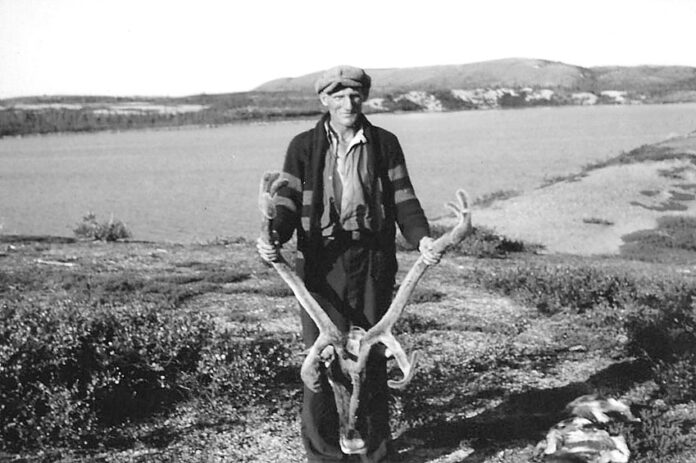
by Joan Champ
Imagine losing touch with your siblings due to war, and never seeing them again for decades. You never know what happened to them – as far as you know, they are dead. There’s no way to find out, especially when you live the isolated life of a trapper in northern Saskatchewan.
This is what happened to John Albrecht, a man I wrote about in an earlier, two-part column (September 21 and 28, 2017 – “A Reporter’s Encounter with Nan Dorland, Prospector”). Circumstances of two world wars separated John from his family for decades, yet the family ties remained strong – strong enough to miraculously bring them back together after almost 40 years of unimaginable challenges. This reunion was brought about in the mid-1960s thanks to the efforts of a Prince Albert resident, S. E. (Bob) Lee, and the German embassy in Toronto.
Bob Lee brought this incredible story to the attention of the Prince Albert Daily Herald back in 1968. An account of John Albrecht’s reunion with his sister, Mrs. Anna Gumboldt (or Gumpoldt), was published on April 16, along with a photograph of the two siblings, Anna’s daughter Margarete, and Bob Lee. The newspaper devoted almost a full page to the stories of the brother’s and sister’s lives. Both siblings experienced adventure and adversity, yet their experiences could not have been more different.
According to Dr. Klaus Lehnert-Thiel’s account of John’s life, published in The Northerner at the time of John’s death in 1991, the Albrecht children led a rather idyllic life on the shore of the Baltic Sea where their father ran the lighthouse. “There, … John spent his youth in an unspoiled environment of unmatched beauty,” Lehnert-Thiel writes. “Fishing, hunting, trapping, skating and sailing were activities which the young John Albrecht enjoyed from a very young age.” The outbreak of the First World War in 1914 changed everything.
At the beginning of the war, the Imperial Russian army invaded Albrecht’s homeland of East Prussia. Sixteen-year-old John volunteered for the German army. For the next two years he served as a machine gunner until he was captured by the British in 1917. He spent three years in a British prisoner-of-war camp. After his release in 1920, he returned to his home country, now annexed by Lithuania. Continuing struggles in the Baltic region led John to emigrate to Canada in 1929. He waved goodbye to his sisters and brother on the pier at Danzig (now Gdansk, Poland), not sure he would ever see them again.
Albrecht arrived in Saskatchewan during the Great Depression. After two years of working on farms, Albrecht headed north to Wollaston Lake where he trapped for the next seven years. Albrecht moved to Stony Rapids in 1939 and trapped from a base on the Saskatchewan-Northwest Territories boundary. In 1948, together with his partner, Albrecht found the Nisto Uranium Mine on the north shore of Black Lake. The following year he “struck it rich” again when he married US radio star, Nan Dorland. Nan died in 1950 a few days after giving birth to their son.
John’s sister Anna escaped death several times during the Second World War. She and her four daughters endured 13 years in a Russian forced labor camp. Anna told the Herald reporter that her children suffered the most. Starvation was always with them. Her daughter Margarete was hit in the head by a Russian rifle butt, leaving her with a permanent scar. Her daughter Sigrid lost some of her toes to frostbite. With the children of other families in the camp dying one after another, Anna refused to give up. “I’d steal, beg and do almost anything to get something for the children to eat,” she recalled. “If I had been caught, it would probably have been Siberia.” Anna returned home from the fields one evening to discover that her mother and two of her daughters, 4-year-old Margarete and 5-year-old Bridget had been taken away on a forced march to Poland. That night, Anna and her two remaining daughters slipped away from the camp and began what became a six-month search. When she found them, her mother had died and neither of her daughters could walk. Carrying the young girls on their backs, Anna and her older daughters travelled back to the family home in Lithuania. By the time they got home, two of the girls required stomach surgery due to the horrors they had endured.
Fast forward to 1968, when Anna Gumboldt, along with her daughter Margarete, reunited with her brother, John Albrecht in Prince Albert, Saskatchewan. “It’s a miracle we ever found John,” Anna said to the Herald reporter. “We all thought he had died in the wilderness of northern Saskatchewan where we got our last letters from him.” “Yes, you thought I was dead,” John replied, “and I thought you were all dead in the war. Now we find that almost the whole family is still living.” Margarete eventually moved to Canada to live with her uncle, first in LaRonge, then in Langley, BC, where Albrecht died in 1991 at age 93.
War divides and separates families and tests familial bonds. But the ties of a family transcend war and through trying times remain intact no matter the challenges endured.
Contact: joanchamp@shaw.ca

